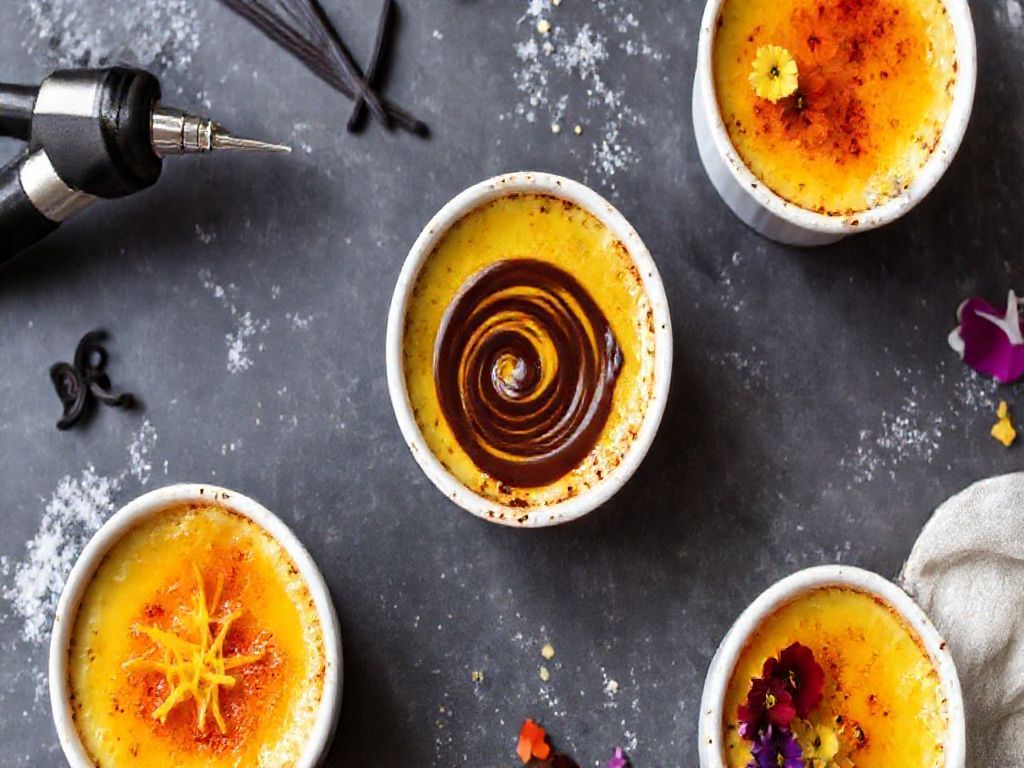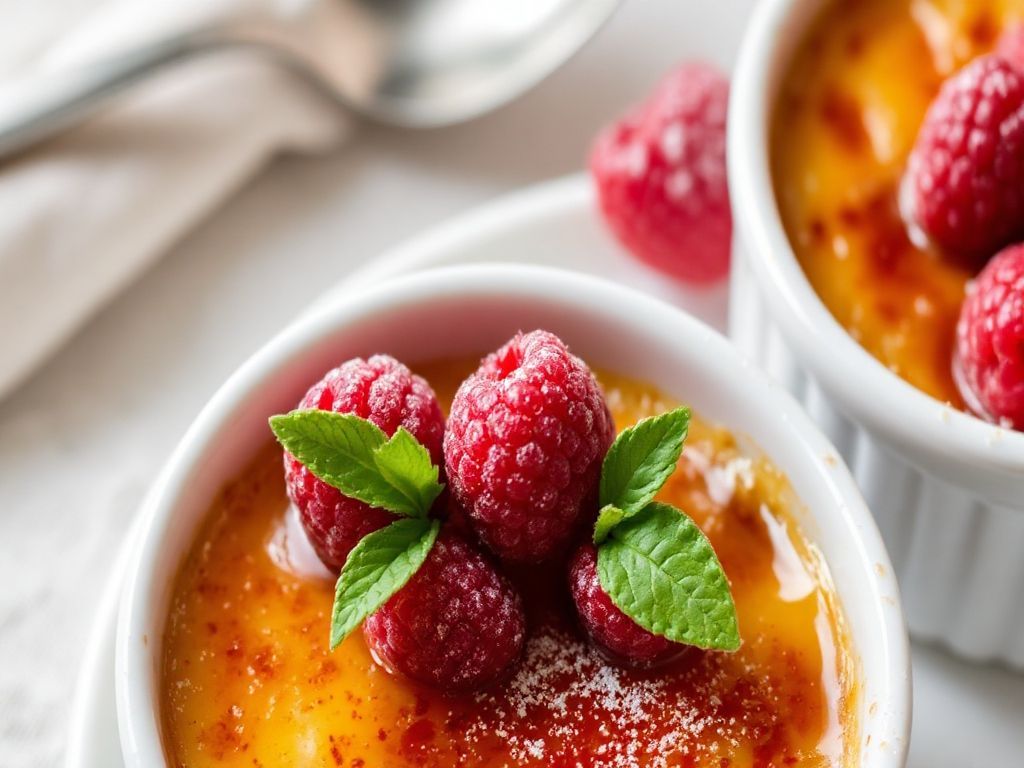Few desserts captivate the senses quite like crème brûlée. With its luxurious, velvety custard and crisp caramelized sugar crust, this timeless dish remains a symbol of culinary elegance. However, what distinguishes a truly exceptional crème brûlée from an average one? The answer lies in technique, balance, and a touch of artistry.
In this guide, we’ll explore the secrets to crème brûlée perfection, from creating the ideal custard to troubleshooting common challenges. By the end, you’ll be able to craft a dessert that’s not only impressive but also unforgettable.
Why Crème Brûlée Is So Special
At its core, crème brûlée is deceptively simple, yet it’s endlessly elegant. Its allure comes from the perfect balance between its silky custard base and the crunch of the caramelized sugar topping. Together, these elements create a dessert that is indulgent, satisfying, and universally loved.
Key Components:
- Custard Base: A creamy mixture of heavy cream, egg yolks, sugar, and vanilla, baked to smooth perfection.
- Caramelized Sugar Topping: A thin layer of sugar, torched or broiled until crisp, provides the iconic crack.
Although the concept appears straightforward, executing this dish flawlessly requires precision and attention to detail.

The Secrets to Perfect Crème Brûlée
1. Perfecting the Custard
The custard should be creamy, smooth, and firm enough to hold its shape. To achieve this, you’ll need to focus on a few critical steps.
Use the Right Ingredients:
- Heavy Cream: To achieve the richest texture, always use heavy cream. Lower-fat options, in contrast, can result in a thinner custard.
- Egg Yolks: These provide the structure and richness of the custard. Always use fresh yolks for the best results.
- Vanilla Bean or Extract: A real vanilla bean not only adds depth but also creates the beautiful black specks in the custard. If unavailable, high-quality vanilla extract works just as well.
Techniques for Success:
- Heat the Cream Gently: Warm the cream just until steaming, then slowly add it to the whisked egg yolks to temper them. This step prevents curdling and ensures the custard will be smooth.
- Strain the Mixture: After combining the cream and egg mixture, strain it through a fine-mesh sieve. This step not only removes lumps but also guarantees a velvety texture.
- Balance the Ratio: For the perfect consistency, use one cup of heavy cream for every two to three egg yolks. This ratio ensures the custard is rich yet not overly dense.
Moreover, remember to stir gently when combining the ingredients to avoid incorporating too much air, which can create bubbles.
2. Baking Like a Pro
Even when you’ve nailed the custard mixture, the baking process is equally crucial to your success. Without proper attention, the custard can curdle or fail to set.
Use a Water Bath (Bain-Marie):
- Always place the ramekins in a deep baking dish and pour hot water into the dish until it reaches halfway up the sides of the ramekins. This method ensures even cooking and prevents the edges from overheating.
Bake at a Low Temperature:
- Bake at 300°F (150°C) for slow, gentle cooking. High heat can lead to a rubbery texture or cracks, which ruin the custard’s luxurious quality.
The Jiggle Test:
- When the custard is done, the edges will be set while the center still jiggles slightly when shaken. This jiggle indicates the custard is perfectly cooked, as it will firm up during cooling.
Additionally, avoid overbaking, as this can result in a dry and grainy texture.
3. Caramelizing the Sugar Topping
The caramelized sugar crust is what transforms crème brûlée into a sensory delight. While this step may seem simple, it’s essential to execute it with care.
Choose the Right Sugar:
- Use superfine or caster sugar for an even melt and smooth finish. Coarser sugars, such as turbinado, can work but may result in a thicker crust.
Layering Technique:
- Sprinkle a thin, even layer of sugar over the chilled custard.
- Tilt the ramekin to distribute the sugar uniformly, tapping off any excess for consistency.
Torch Like a Pro:
- A culinary torch delivers the best results. Move the flame in a circular motion to avoid burning any one spot. If using a broiler instead, place the ramekins on the top rack and monitor them closely.
Let It Rest:
- After caramelizing, allow the sugar crust to harden for at least one to two minutes before serving. This step ensures the topping will crack satisfyingly under a spoon.
Creative Twists on Crème Brûlée
Once you’ve mastered the classic recipe, experimenting with flavors can elevate this dessert to a whole new level. With a few creative twists, you can customize it to suit any occasion.
Flavor Enhancements
- Chocolate: Melt dark chocolate into the cream for a rich, indulgent twist.
- Espresso: Add brewed espresso or instant coffee granules for a bold and sophisticated flavor.
- Citrus: Infuse the cream with orange or lemon zest for a refreshing touch.
Savory Options
Surprisingly, crème brûlée doesn’t have to be sweet. For example:
- Cheese Crème Brûlée: Use Parmesan or Gruyère for a savory custard.
- Herb-Infused: Add rosemary, thyme, or basil for a unique flavor profile.
Alcohol-Infused Variations
For a more luxurious version, consider adding a splash of:
- Grand Marnier or Cointreau for citrus notes.
- Amaretto for nutty sweetness.
- Irish cream or bourbon for a warming, decadent finish.
By infusing these flavors, you can tailor the dessert to suit any palate or event.
Avoiding Common Mistakes
Even with careful preparation, things can occasionally go wrong. Here are the most common issues and how to fix them:
Problem: Grainy Custard
- Cause: Overheating or curdled eggs.
- Solution: Always use a water bath and bake at a consistent low temperature.
Problem: Runny Custard
- Cause: Undercooking or insufficient chilling time.
- Solution: Bake until the edges are set, and refrigerate for at least 2–4 hours before serving.
Problem: Burnt Sugar Topping
- Cause: Holding the torch too close or broiling for too long.
- Solution: Always keep the flame moving and stop caramelizing as soon as the sugar turns golden brown.
Serving Crème Brûlée with Style
Presentation plays a crucial role in elevating crème brûlée from delicious to unforgettable. With these tips, you’ll impress your guests before they even take a bite.
Plating Ideas
- Use classic white ramekins for a timeless look, or opt for colorful or patterned ramekins to add a modern flair.
- Serve the ramekin on a small dessert plate, garnished with a drizzle of berry coulis.
Garnishes
- Fresh berries, such as raspberries or blueberries, provide a pop of color and tartness.
- Edible flowers, like pansies or violets, add elegance and charm.
- A sprig of fresh mint offers a simple yet striking visual touch.

FAQs About Crème Brûlée
- Can I make crème brûlée without a torch?
Yes! You can use a broiler, but keep a close eye to prevent burning. - Can I prepare it ahead of time?
Absolutely. The custards can be refrigerated for up to 3 days before caramelizing the sugar topping. - What cream works best?
Heavy cream is essential for a rich, smooth custard. - Why is my custard watery?
It likely wasn’t baked long enough or the cream-to-egg ratio was off. - Can I freeze crème brûlée?
You can freeze the custard base, but caramelize the sugar fresh for the best texture. - What sugar is best for the topping?
Superfine sugar melts evenly for a smooth crust. - How do I fix scrambled custard?
Straining the mixture before baking will remove any curdled bits. - Can I add alcohol to the custard?
Yes, a splash of liqueur like Grand Marnier or Amaretto enhances the flavor. - How long does it take to set?
Chill the custards for 2–4 hours, or overnight for best results. - What pairs well with crème brûlée?
Serve with espresso, dessert wine, or fresh fruit for a perfect pairing.
By incorporating these tips and techniques, you’ll not only master crème brûlée but also create a dessert that will leave a lasting impression. With practice and creativity, this classic dish can be transformed into your own signature masterpiece.

